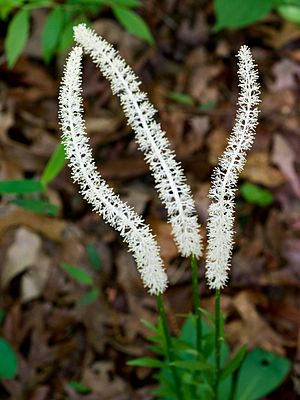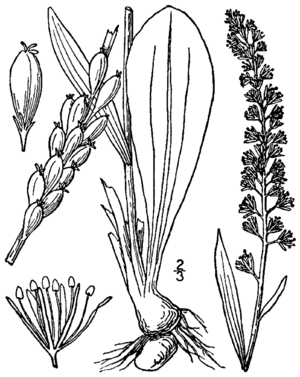Blazing-star facts for kids
Quick facts for kids Blazing-star |
|
|---|---|
 |
|
| Inflorescence | |
| Conservation status | |
| Scientific classification | |
| Genus: |
Chamaelirium
|
| Species: |
luteum
|
| Synonyms | |
|
List
|
|
Chamaelirium is a type of flowering plant with only one species, Chamaelirium luteum. It's known by many fun names like blazing-star, devil's bit, false unicorn, fairy wand, and helonias. This plant is a perennial herb, which means it lives for more than two years. It grows naturally in the eastern parts of the United States. You can find it in different places, such as wet meadows and deciduous woodlands (forests where trees lose their leaves in autumn).
The Chamaelirium luteum plant usually has a group of about six leaves at its base. These leaves are about 8–15 cm long. From the center of these leaves, a single flower stalk grows upwards. This stalk has many small flowers packed closely together, forming a spike-like shape. The flower part is about 1–1.5 cm wide and 8–30 cm long.
These plants are usually dioecious. This means that individual plants are either male or female, having only male or only female flowers. In a group of these plants, there are often more male plants than female ones. This happens because female plants don't live as long and don't flower as often. Female stalks tend to grow taller, reaching up to 1.2 meters. However, they usually have about ten times fewer flowers than male plants.
Chamaelirium luteum is the only plant in its genus, making it a "monotypic" genus. It is quite rare, especially at the edges of the areas where it grows.
Contents
Where Does It Grow?
You can find Chamaelirium luteum in the cooler parts of North America, including the United States and Canada. It grows east of the Mississippi River. Historically, it was also known to grow in southern Ontario.
What Does Its Name Mean?
The name Chamaelirium luteum comes from ancient Greek words.
- Chamai means "on the ground".
- Leirion means "lily".
- Luteus means "yellow".
So, its name basically means "yellow ground lily".
Growing This Plant
Because Chamaelirium luteum is often picked from the wild, it's at risk of disappearing. People are working on ways to grow it on farms to meet the demand.
Choosing a Good Spot
Chamaelirium luteum likes soil that is moist but also drains water well. It prefers acidic soil (with a pH between 4.5 and 6) that has a lot of humus (rich, dark soil from decomposed plants). If you plant it in an open field, it needs some shade to protect it from too much sun. For growing in a forest, it's best to plant it where there are tall hardwood trees to provide natural shade.
How to Plant It
You can grow Chamaelirium luteum in two ways: from seeds or by dividing its roots.
For growing from roots, you can cut the underground stems, called rhizomes, into small pieces about 6 mm (1/4 inch) thick. These disc-shaped pieces should be left overnight to form a protective layer, then planted in pots the next day. Keep the soil moist and shaded until the plants start to grow. Once they are young plants, you can move them to a well-prepared garden bed. This bed should have lots of organic material. Plant them about 15–25 cm (6–10 inches) apart. To give the plants nutrients, add pine needles, rotted sawdust from conifer trees, or bark mulch to the topsoil.
If you want to grow them from seeds, plant the seeds about 3 mm (1/8 inch) deep in breeding beds with lots of humus. Do this in late autumn or early winter. For the seeds to sprout well, they need to go through a process called stratification. This means they need a period of cold and moisture, like winter. The plants grow best in a mix of peat moss and old pine needles. When the young plants appear, let them grow without moving them for at least one full growing season. After that, you can transplant them just like you would with plants grown from root divisions.
Taking Care of the Plant
The plant needs to stay moist and shaded. It also needs protection from animals that like to eat plants, such as snails, slugs, or deer in wooded areas. Make sure to remove any weeds that grow around the plants.
What Is It Used For?
Chamaelirium luteum is used as a pretty garden plant or as a medicinal herb. Long ago, Indigenous peoples used it a lot.
Traditionally, it was used to help with healthy pregnancies and was thought to help with having babies. Today, it is used to help with menstrual problems, issues related to pregnancy, and other women's health concerns. It is also used for ovarian cysts and as a diuretic (something that helps the body get rid of extra water).
The rhizomes (underground stems) can be collected after six years. This is usually done in the autumn, after the plant has produced its mature seeds. After removing soil and roots from other plants, the rhizome should be stored without washing it. It's important to keep it from drying out too much or getting too wet, which could cause mold. Before using it, the rhizome should be washed carefully.
Active Ingredients
The helpful parts of the plant are a mix of natural compounds called steroidal saponins. These include chamaelirin and aglycone diosgenin. These substances can act as an emmenagogue (something that helps with menstruation), a diuretic (helps remove water from the body), and sometimes an emetic (something that can cause vomiting).
Images for kids
See also
 In Spanish: Chamaelirium para niños
In Spanish: Chamaelirium para niños





